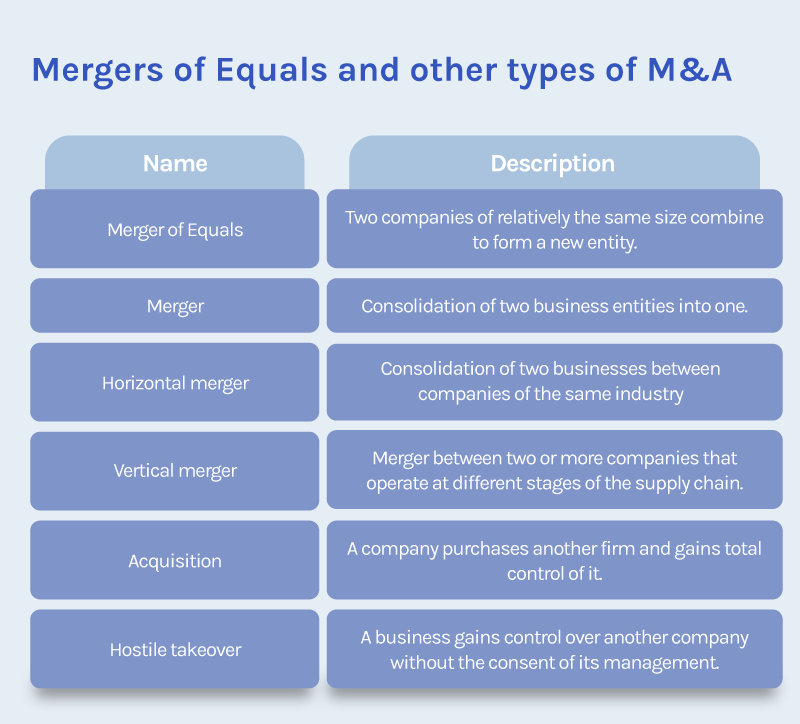Also known as MOE, a merger of equals occurs when two companies of a similar size combine to form a new entity.
After a merger of equals, the independent companies cease to exist and all their assets are transferred to the new entity.
Shareholders from both firms surrender their shares in exchange for securities issued by the new company. Ideally, in a MOE, the shareholders from the former companies will have a similar percentage of stock and a similar number of members on the board of directors.
How does a merger of equals work?
The merger of equals works as a stock-for-stock exchange in which the selling shareholders will own a meaningful percentage of the new company. There is no buyer and no cash involved.
In a MOE, the two companies will go through a business valuation, and base the financial contribution of the new company on this appraisal.
The shares are often distributed on a pro-rata basis, which means they are divided according to the worth of the company. For this reason, most transactions will not be split on a 50/50 basis.
Companies must decide whether to combine the roles of CEO and chairman of the board or divide the responsibilities between the CEOs. It is common for companies to determine for both executives to share the power, or split the roles for a defined time.
The board of directors of the new company is divided evenly between directors from each company.
Once the companies have agreed on the terms of the new management, organization, branding, marketing, and the concerning modifications, the new entity is formed and able to start operations as a brand-new corporation.
The controversy around mergers of equals
It is commonly implied that mergers of equals do not exist, simply because no company is equal to the other. Companies differ in terms of size, growth, business objectives, and other operational concerns.
The most recurrent argument against this term is that both companies rarely benefit equally from this business transaction, for there is always a dominant partner.
This superiority can cause hostility in the newly-formed company, which is one of the reasons why corporate marriages are rarely successful in the long term.
The term merger of equals, some people argue, is mostly used to satisfy the press. Also, as the former head of Chrysler implied, for “psychological reasons”, this euphemism helps companies to conceive the transaction in friendlier terms.
Advantages and disadvantages of MOE
With the consolidation of two companies the new entity can improve its performance, but this business transaction can also involve difficulties.
Benefits
- Accelerated growth: By joining skills, technology, and financial resources, the new entity will be able to increase its asset size and product line, therefore, its profitability.
- Expansion: Ability to introduce to foreign markets and expand operations.
- Brand awareness: Both companies can benefit from each other’s built-in customer base and reputation.
Disadvantages
- Deal complexity: The structuring of the transition and negotiation can be time-consuming and costly.
- Antitrust issues: There are hefty regulations regarding antitrust laws.
- Disputes: Mergers of equals face a high risk of dispute, due to the transaction’s requirement for executives to give up their control. Similarly, making decisions regarding organizational and operational concerns increases the possibility of failure.
Difficulties in the process of transition
Share of power
Ego is one of the main causes of disputes in every transaction, and mergers of equals are no exception. When two companies combine, both want to be perceived as winners.
Decisions need to be made, and one of the primary conflicts is selecting who will be the CEO of the new company. This, along with the rest of the organizational decisions, hinders the operational process and affects the whole organization.
Corporate Culture
The most important mergers of equals have occurred between companies from different countries. But even when companies have relatively equal backgrounds, they are going to face a clash of cultures.
The merging companies may significantly differ in compensation methods, communication protocols, strategic vision, and other directive decisions.
Employee retention
A merger of equals potentially involves redundancies, restructuring, and reassigning roles and responsibilities. This, along with changes in the compensation philosophy, will surely cause discontent among the workforce of the new company.
Rebranding
Just as Chrysler and Daimler did, former companies can choose to combine their names for the new entity. However, this merger should always come with a rebrand, and creating a new identity that captures each company’s essence and unifies it is challenging.
Example of Mergers of Equals
Wells Fargo and Norwest
In 1998, banking companies Wells Fargo and Norwest Corporation entered a $34.4 billion deal to create an extensive banking network in the United States.
The purpose of the merger was to complement their products and technology to improve their financial services around the US, Canada and Latin America.
The companies faced different obstacles, such as their contrasting cultures. While Norwest was known for its customer service, Wells Fargo focused on efficiency through online banking and technology.
Combined, both companies diversified their financial services and ranked first among bank and insurance companies. In 2022, the company’s revenue reached $73.8 billion.
A merger of equals offers the opportunity to grow exponentially but also exposes the parties to a vulnerable position. For this reason, to ensure a smooth integration the parties must include an M&A lawyer and an accountant early in the process that will assess any potential risk.


